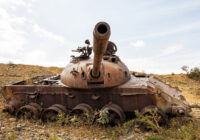On Wednesday November 2, a day before the second anniversary of the tragic war in the northern Ethiopian region of Tigray, a peace agreement was signed following ten days of hard negotiations. The government of Ethiopia and the Tigray People’s Liberation Front (TPLF) signed the peace deal in the South African capital, Pretoria. It has been widely welcomed. A spokesman for the White House said: “The United States remains committed to supporting this African Union-led process as it continues and to partnering to ensure it brings a lasting peace to Ethiopia.”
Yet the African Union brokered agreement is odd. It fails to mention one of the key participants in the conflict: the government of Eritrea. This is extraordinary since the Eritreans have tens of thousands of troops battling the Tigrayans. The agreement contains just one oblique reference to Eritrea’s role. Article 3/3 states that: “This Permanent Cessation of all forms of hostilities shall include…subversion or the use of proxies to destabilise the other party or collusion with any external force hostile to either party.”
The word “Eritrea” is never mentioned, yet the reality is that this war was primarily the brainchild of Isaias Afwerki, Eritrea’s unelected president and the region’s strongman. It is at his behest that conscripts have been rounded up and sent to fight in neighboring Ethiopia.
The Highway from Hell and House to House Conscription
All along the B30 highway – deep inside Tigray – Eritreans troops are under siege, fighting for their lives. The road links the western city of Shire, the sacred site of Axum and the historic town of Adwa, scene of the famous Ethiopian victory over the Italians in 1896. Today it has become the Highway from Hell, with beleaguered Eritrean and Ethiopian forces under constant attack from Tigrayan ambushes.
Some will wonder why Eritreans are inside Ethiopia at all. On March 21, 2001, Ethiopian Prime Minister Abiy Ahmed said Eritrean troops would be withdrawn. Yet 20 months later the Eritreans are still fighting on Ethiopian soil.
Eritreans in the diaspora tell of friends and families terrified into giving up their children to go and fight, and of Afwerki’s notorious security forces going door-to-door to search out the few remaining young men and women who can be taken away for “National Service”. Many will never return.
There are first-hand accounts of men as old as 70 being forced into conscription. Families that resist are put out onto the streets – with anyone coming to their aid facing the same humiliating penalty. Eritrean hospitals are reportedly overflowing with wounded soldiers who have been ferried back from the front. Some can hardly cope with the dead and dying.
Ethiopian divisions transferred to Eritrean
It now seems clear that while the fighting is inside Ethiopia, it is Eritrea that is pulling the strings. The Daily Telegraph reported that Ethiopian troops had been transferred to Eritrea as the current offensives were erupting on August 26.
One source at Ethiopian Airlines told The Daily Telegraph that the country’s flagship carrier has been chartering dozens of flights to ferry soldiers and weapons up north to the frontline. Flight data showed a significant uptick in unscheduled domestic chartered flights last month, which flew in the direction of Lalibela, a key logistics hub for the Ethiopian army near the frontline. On just one day, September 1, at least eight Boeing 737s with a capacity of 180 soldiers and four Canadian made De Havilland Dash 8-400 with a capacity of 90 appeared to set off for Lalibela.
This is very much in line with what Alex de Waal reported on October 7: “About 30 [Ethiopian National Defense Force] ENDF divisions relocated from Amhara and Western Tigray into Eritrea last month, placing themselves under Eritrean overall command.” This is exactly as Afwerki would wish it to be. His is the hand that will guide the region’s reconstruction, if the Tigrayans can be eliminated.
Just prior to the war commencing in November 2020, Afwerki brought his closest political and military advisers together for an intense discussion on how to proceed. The president told them that the country had to accept that it has a small and not very viable economy and a lengthy Red Sea coast, which Eritrea cannot patrol on its own. He is reported to have suggested that some sort of “union” with Ethiopia might be possible, at least in terms of economic co-operation and maritime security.
War has been Afwerki’s modus vivendi ever since Eritrean independence in 1993. He has fought all his neighbors – from Sudan to Djibouti – and sent Eritrean troops as far as the Congo. As Asia Abdulkadir, a Kenyan analyst put it to Bloomberg: “War is the way for Afwerki to stay involved in Ethiopia’s politics” and peace is simply not an option as long as the TPLF are still around, she said.
How Afwerki responds to Wednesday’s peace agreement is hard to predict, but he is unlikely to end the plotting that has been his modus operandi for the past five decades.
The views expressed in this article are the author’s own and do not necessarily reflect Fair Observer’s editorial policy.
Support Fair Observer
We rely on your support for our independence, diversity and quality.
For more than 10 years, Fair Observer has been free, fair and independent. No billionaire owns us, no advertisers control us. We are a reader-supported nonprofit. Unlike many other publications, we keep our content free for readers regardless of where they live or whether they can afford to pay. We have no paywalls and no ads.
In the post-truth era of fake news, echo chambers and filter bubbles, we publish a plurality of perspectives from around the world. Anyone can publish with us, but everyone goes through a rigorous editorial process. So, you get fact-checked, well-reasoned content instead of noise.
We publish 2,500+ voices from 90+ countries. We also conduct education and training programs
on subjects ranging from digital media and journalism to writing and critical thinking. This
doesn’t come cheap. Servers, editors, trainers and web developers cost
money.
Please consider supporting us on a regular basis as a recurring donor or a
sustaining member.
Will you support FO’s journalism?
We rely on your support for our independence, diversity and quality.







Comment